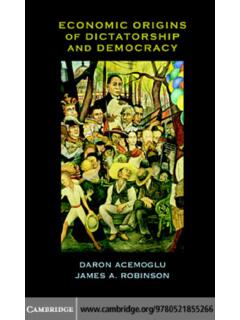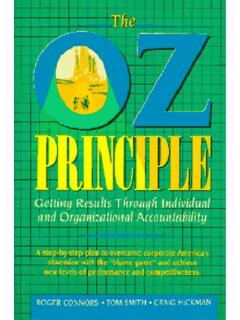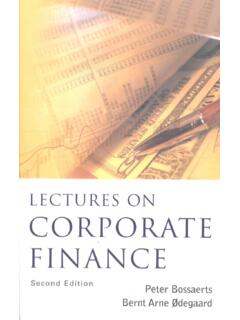Transcription of Politics in the USA - untag-smd.ac.id
1 Politics in the Vile s classic introductory text, Politics in the USA, has now been thor-oughly revised and updated to take account of the considerable developments in American Politics over the last ten years. The book provides students with an essential background to the history and development of the American political system as well as an explana-tion of its key structures, processes and institutions. The book establishes a framework within which to understand the intricacies of Politics in the world s most powerful nation. This new edition provides students with: a chapter on US foreign policy including the significant developments under Clinton and George W. Bush, including the Iraq War; an analysis of Bush s presidency and the rise of neoconservatism; the discussion of controversial issues such as abortion, immigration, the death penalty, Hurricane Katrina, and Guant namo Bay and civil rights; suggestions for further reading and relevant websites for each is the most up-to-date and readable textbook on American Politics .
2 As such, it will be of interest to all students of Politics and international Vile is Professor Emeritus of Political Science at the University of in the USAS ixth VileFirst published 1970 by Routledge2 Park Square, Milton Park, Abingdon, Oxon OX14 4 RNSimultaneously published in the USA and Canadaby Routledge270 Madison Ave, New York, NY 10016 Routledge is an imprint of the Taylor & Francis Group, an informa business 2007 VileAll rights reserved. No part of this book may be reprinted or reproduced or utilised in any form or by any electronic, mechanical, or other means, now known or hereafter invented, including photocopying and recording, or in any information storage or retrieval system, without permission in writing from the Library Cataloguing in Publication DataA catalogue record for this book is available from the British LibraryLibrary of Congress Cataloging in Publication Data Vile, Politics in the USA / by Vile 6th ed.
3 P. cm. Includes bibliographical references and index. 1. United States Politics and government. I. Title. 2007 dc22 2006025475 ISBN 10: 0-415-41419-9 (hbk)ISBN 10: 0-415-41418-0 (pbk)ISBN 10: 0-203-43704-7 (ebk)ISBN 13: 978-0-415-41419-7 (hbk)ISBN 13: 978-0-415-41418-0 (pbk)ISBN 13: 978-0-203-43704-9 (ebk)This edition published in the Taylor & Francis e-Library, 2007. To purchase your own copy of this or any of Taylor & Francis or Routledge scollection of thousands of eBooks please go to ISBN 0 203 43704 7 Master e-book ISBNFor NancyContentsList of illustrations ix 1 A government of limited powers 1 2 The nature of American Politics 18 3 The two-party system 45 4 Politics and elections 74 5 Pressure Politics 103 6 Congressional Politics 120 7 Presidential Politics 148 8 The media and Politics 182 9 Politics and the administration 194 10 Politics and the judiciary 209 11 The making of American domestic policy 234 12 The making of American foreign policy 259 Postscript.
4 American Politics in the twenty-first century 282 Appendix 1 286 Appendix 2 303 Index 309 List of illustrationsFigures The electoral process 76 The judicial system of the USA 223 Maps The progress of settlement 9 The establishment of the American states 12 The election of 1896 23 The election of 1960 25 The election of 2000 26 Tables The 2004 presidential election 29 Percentage of votes cast for the Democratic and Republican presidential candidates, 1936 2004 31 Voter turnout: presidential elections 38 A1 Presidents and Vice-Presidents of the United States 303 A2 Chief Justices of the United States Supreme Court 305 A3 Presidential elections: the Popular Vote and Electoral College votes, 1932 2004 306 A4 Composition of Congress, 1933 2005 3071 A government of limited powersThe Constitution of the United States is little more than two hundred years old.
5 It has survived civil war and the territorial expansion from thirteen largely agricultural former colonies on the eastern seaboard to an industrial nation of fifty states that stretch across the continent to Alaska and to Ha-waii. It has overseen the emergence of the most powerful democracy in the world. The American political system was subjected to severe strains in the twentieth century: the need to mobilise for two world wars , the depression of the 1930s, the changing role of government since the Second World War, the challenge of the civil rights movement, the impact of the vietnam War and the shock of the Watergate affair which resulted in the resignation of Presi-dent Richard Nixon. In the first years of the twenty-first century the chal-lenges seemed to multiply rapidly: the terrorist attack on the World Trade Center in New York and on the Pentagon, the wars in Afghanistan and Iraq, Hurricane Katrina and its aftermath.
6 The major challenge to American soci-ety, however, has been developing since the end of the war in vietnam . That war jolted the faith of Americans in the inevitability of progress, and in the superiority of their system of government. It also brought to an end the era of the melting pot , the assumption that all Americans, whatever their origin, would assimilate to American values, adopt English as their first language, and necessarily revere the institutions embodied in the Constitution of the United States. In other words, America has had to face the fact that it is a multicultural society. In spite of these challenges, superficially the most striking characteristic of the American Constitution is its continuity and stability, the unchanging shape of its major structures. Within this apparently stable framework, how-ever, deep and significant changes in the nature and working of the American political system have taken place: the changing character of the system of federalism; the continuously fluctuating relationship between Congress and the presidency; the transformation of the system of political parties; the rise of the mass media and their impact upon the political system; the changing role of the Supreme Court; these and many other factors affect the working of Politics in the United States at the beginning of the twenty-first century.
7 2 A government of limited powersIt will be our task to explore the building blocks that go to make up this complex pattern, to try to bring out the rich variety of American political life, and to assess the direction in which it is challenge of American historyThe history of what was to become the United States of America illustrates the diversity of the origins of the country, and also explains the structure of its institutions. In the sixteenth century the European powers, Spain, France and England, began to settle on the mainland of North America. Spain made repeated efforts to colonise Florida, establishing the city of St Augustine in 1565, then pushing northwards and establishing missions. Florida became British in 1763, reverting to Spain after the War of Independence.
8 Spain also settled California, but not until the eighteenth century, establishing a mis-sion at San Diego in 1769. California became part of the newly independent Mexico in 1821, and was ceded to the United States in 1848 along with New Mexico, Texas having been annexed in 1844. France, in addition to its colo-nisation of Canada, expanded into the Mississippi Valley and founded the city of New Orleans in 1718. By the middle of the eighteenth century France laid claim to a huge tract of land stretching from the Gulf of Mexico to Hud-son s Bay. The defeat of the French by the British in Canada in 1759 and the purchase of Louisiana by the United States in 1803 ended French colonial power in North America. The Dutch established New Amsterdam, renamed New York when captured by the British in 1664.
9 Alaska was part of the Rus-sian Empire until purchased by the United States in 1867. The Kingdom of Hawaii was annexed by the United States in 1898 and became the fiftieth state in 1959. The English, in contrast to the Spaniards and the French, developed their American colonies largely through commercial expansion, the Crown granting huge tracts of land to companies to develop trade. Starting with the Royal Charter of the Virginia Company in 1606 a series of expeditions were mounted which by the 1770s had resulted in the establishment of thirteen colonies poised on the east coast of the continent. Each colony had its distinct social composition and religious affiliations, and its own economic interests. Each colony had its own constitutional structure; attempts were made to establish a system of government reaching across the colonies, but they did not succeed, and therefore until the Revolution the colonies political links were with London.
10 Thus when independence came in 1776 the colonies transformed themselves into independent states, each state establishing its own constitution, and only loosely affiliating with other states through the Articles of Confederation in order to conduct the war against the Convention of the representatives of the states met in Philadel-phia in 1787 to recommend a new form of government for the United States of America they had two main concerns. First, they wished to create a system of government that would be strong enough to defend their territory against A government of limited powers 3attack, and which would have the basic unity through a common currency to provide the opportunity for economic development. But they did not wish to destroy the states, or to strip them of their role as the main sources of civil and criminal law for their citizens.











